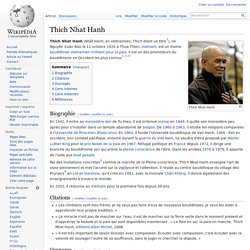

Thich Nhat Hanh. Un article de Wikipédia, l'encyclopédie libre.

Thich Nhat Hanh (Nhất Hạnh, en vietnamien, Thích étant un titre[1]), né Nguyễn Xuân Bảo le 11 octobre 1926 à Thua Thien, Vietnam, est un moine bouddhiste vietnamien militant pour la paix. Il est un des promoteurs du bouddhisme en Occident les plus connus[2],[3],[4] Biographie[modifier | modifier le code] En 1942, il entre au monastère zen de Tu Hieu. Il est ordonné moine en 1949. Par des invitations concrètes[5] comme la marche de la Pleine conscience, Thich Nhat Hanh enseigne l'art de vivre pleinement et met l'accent sur la vigilance et l'attention. En 2005, il retourne au Vietnam pour la première fois depuis 39 ans. Citations[modifier | modifier le code] « Les chrétiens sont mes frères. Ouvrages[modifier | modifier le code] La Paix un art, une pratique. A Gift from Thich Nhat Hanh (Thay) to All of Us.
Last week I wrote about Thich Nhat Hanh’s brain hemorrhage landing him in the hospital.

The most recent update from Plum Village shows that while his condition is still in a critical stage he has opened his eyes and even reached out to touch the attendant next to him. In continuing this time of honoring his life I wanted to share with you one of the gifts he has given me that I often share with others. These are the short phrases he weaves into breathing or walking that helps us be more present, loving, grounded, and aware in daily life. If you don’t already, consider trying these out as an experiment in your daily life and seeing what you notice. For example, You may take three steps while breathing in and say “Breathing in, I calm my body” and then with the following three steps “Breathing out, I relax.”
These are just some examples; you can make up your own that fit for you. No matter how many breaths Thay has left, his life has touched millions and he will never leave us. The Doors of Liberation. The Great Zen Buddhist Teacher Thich Nhat Hanh on How to Do “Hugging Meditation” By Maria Popova “When we hug, our hearts connect and we know that we are not separate beings.”

“I embrace you with all my heart,” Albert Camus wrote in his beautiful letter of gratitude to his childhood teacher shortly after winning the Nobel Prize. To embrace one another with our whole hearts is perhaps the greatest act of recognition and appreciation there is. To do so in more than words is the ultimate gift of our shared humanity. And yet despite this awareness — or perhaps precisely because of it; because of its enormity — we rarely give each other this gift. How to perform this highest act of generosity is what legendary Zen Buddhist monk, teacher, and peace activist Thich Nhat Hanh (b.
“Spirituality doesn’t mean a blind belief in a spiritual teaching,” Nhat Hanh writes. In the late 1960s, Nhat Hanh invented — in the most organic and inadvertent way — a simple practice that brings embodied form to the communion and mutual understanding at the heart of this spiritual intimacy. How to Love: Legendary Zen Buddhist Teacher Thich Nhat Hanh on Mastering the Art of “Interbeing” By Maria Popova “To love without knowing how to love wounds the person we love.”

What does love mean, exactly? We have applied to it our finest definitions; we have examined its psychology and outlined it in philosophical frameworks; we have even devised a mathematical formula for attaining it. And yet anyone who has ever taken this wholehearted leap of faith knows that love remains a mystery — perhaps the mystery of the human experience. Learning to meet this mystery with the full realness of our being — to show up for it with absolute clarity of intention — is the dance of life.
That’s what legendary Vietnamese Zen Buddhist monk, teacher, and peace activist Thich Nhat Hanh (b. Indeed, in accordance with the general praxis of Buddhist teachings, Nhat Hanh delivers distilled infusions of clarity, using elementary language and metaphor to address the most elemental concerns of the soul. If you pour a handful of salt into a cup of water, the water becomes undrinkable. Donating = Loving. Site officiel de Thich Nhat Hanh.